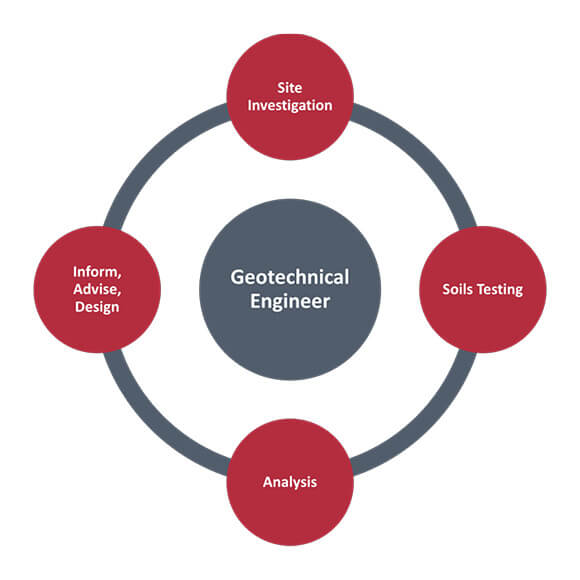Some Ideas on Geotheta You Need To Know
Table of ContentsA Biased View of GeothetaThe 9-Minute Rule for GeothetaNot known Details About Geotheta Examine This Report about GeothetaMore About Geotheta

They conduct site examinations, accumulate samples, carry out research laboratory examinations, and assess data to evaluate the suitability of the ground for building and construction jobs - Consulting Engineer. Based upon their searchings for, geotechnical designers offer recommendations for foundation design, slope stability, maintaining structures, and reduction of geotechnical threats. They work together with other specialists, such as designers, architectural designers, and building teams, to ensure that geotechnical considerations are integrated right into the general task layout and application
By assessing the actions and properties of dirt and rock, they can identify prospective geotechnical dangers such as landslides, soil negotiation, or slope instability. Their know-how helps avoid failures or accidents that could jeopardize lives and residential property. Here are some in-depth duties and obligations of a geotechnical engineer: Site Examination: Geotechnical designers conduct site investigations to gather data on subsurface problems.
They translate the information to understand the properties and actions of the soil and rock, including their stamina, leaks in the structure, compaction attributes, and groundwater conditions. Geotechnical Analysis and Layout: Geotechnical designers examine the data gathered during site examinations to assess the stability and suitability of the site for building and construction jobs. They execute geotechnical estimations and modeling to assess elements such as birthing capability, settlement, incline stability, lateral earth pressures, and groundwater flow.
Geotheta Things To Know Before You Buy
Foundation Design: Geotechnical engineers play a vital duty in designing structures that can securely support the designated framework. They assess the dirt conditions and lots requirements to identify the suitable structure type, such as superficial foundations (e.g., grounds), deep foundations (e.g (https://geotheta.jimdosite.com/)., stacks), or specialized strategies like soil enhancement. They think about factors such as settlement restrictions, bearing ability, and soil-structure communication to develop optimum structure styles
They evaluate building and construction plans, monitor site tasks, and carry out field examinations to confirm that the style referrals are followed. If unexpected geotechnical concerns emerge, they evaluate the circumstance and offer suggestions for remediation or adjustments to the layout. Threat Analysis and Reduction: Geotechnical engineers evaluate geotechnical dangers and threats related to the task site, such as landslides, liquefaction, or dirt disintegration.

Collaboration and Interaction: Geotechnical designers work carefully with other experts entailed in a project, such as engineers, structural engineers, and building teams. Reliable interaction and cooperation are necessary to incorporate geotechnical considerations right into the general project layout and construction procedure. Geotechnical engineers provide technological competence, answer inquiries, and make sure that geotechnical requirements are fulfilled.
7 Simple Techniques For Geotheta
Below are some sorts of geotechnical designers: Foundation Engineer: Foundation engineers concentrate on creating and analyzing structures for structures. They analyze the dirt conditions, load requirements, and website qualities to establish one of the most appropriate foundation kind and layout, such as shallow structures, deep structures, or specialized techniques like stack foundations.
They examine the factors affecting slope stability, such as dirt buildings, groundwater conditions, and incline geometry, and create methods to stop incline failures and alleviate threats. Quake Designer: Quake engineers focus on assessing and making frameworks to stand up to seismic pressures. They examine the seismic risk of a website, evaluate dirt liquefaction potential, and develop seismic layout criteria to ensure the safety and security and strength of structures throughout quakes.
They carry out area screening, collect examples, and analyze the collected data to identify the dirt residential properties, geologic formations, and groundwater conditions at a website. Geotechnical Instrumentation Designer: Geotechnical instrumentation engineers concentrate on tracking and determining the habits of dirt, rock, and frameworks. They set up and keep instrumentation systems that monitor elements such as dirt negotiation, groundwater levels, slope motions, and structural variations to assess efficiency and give early cautions of potential problems.
Geotheta Fundamentals Explained
They conduct examinations such as triaxial examinations, consolidation examinations, direct shear tests, and leaks in the structure tests to gather data for geotechnical evaluation and style. Geosynthetics Designer: Geosynthetics engineers concentrate on the style and application of geosynthetic materials, such as geotextiles, geogrids, and geomembranes. They utilize these products to enhance soil security, strengthen slopes, supply drain remedies, and control disintegration.
They often tend to be investigative people, which suggests they're intellectual, reflective, and investigative. They are interested, systematic, logical, analytical, and logical. Some of them are additionally social, implying they're kind, generous, participating, individual, caring, helpful, empathetic, sensible, and friendly - Tailings Engineer.
In the workplace atmosphere, geotechnical designers utilize specialized software program tools to do computations, create designs, and assess data. They prepare records, evaluation project specs, interact with customers and check that employee, and coordinate job activities. The workplace setup gives a conducive environment for study, analysis, and collaboration with various other professionals included in the project.
6 Simple Techniques For Geotheta
They regularly go to project sites to conduct website examinations, assess geotechnical problems, and gather information for analysis. These check outs entail taking a trip to different places, sometimes in remote or difficult terrains. Geotechnical engineers may do soil sampling, conduct examinations, and display building activities to make certain that the geotechnical aspects of the task are being executed appropriately.
Geotechnical designers likewise work in specialized geotechnical research laboratories. In these centers, they perform experiments, do tests on soil and rock examples, and examine the design properties of the materials. Geotechnical research laboratory designers function extensively in these settings, dealing with screening tools, operating instruments, and taping information. They team up with other research laboratory team to ensure exact and reliable screening outcomes.